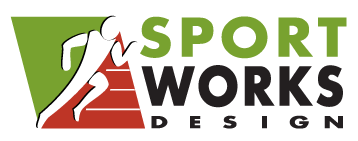Including drainage and GMAX testing in your project plan is often seen as a “nice to have” instead of a “must-have.” Sportworks is here to change that misconception. Including drainage and GMAX testing in your initial plan minimizes unknowns and future hurdles in your renovation / new synthetic turf project. More often than not, clients come to Sportworks after they’ve ripped up their synthetic turf field for replacement and find out that their drainage system needs to be remediated. Our Sports Engineers explain what drainage and GMAX testing are and how it’ll benefit your project and all stakeholders who will use the field.
Drainage Testing
Compared to a natural grass field, synthetic turf fields can handle a significant amount of rain events, increasing your ability to play during or immediately after it rains. Yes, the synthetic turf carpet and infill allows for more substantial drainage than natural grass. However, the limiting factor in the field’s drainage (infiltration) rate is all about the stone base, the top fine stone beneath the turf carpet. Installing the top stone base correctly helps the stone base drain as it should at a recommended >10 inches per hour, leaving your field draining like new 25+ years down the road.
Older fields designed without the big picture in mind have too many fines/dust in the top stone section. These fields require remediation to the stone base during a synthetic turf replacement project. While this mixture of stone may drain well on opening day, over time, the weather and vibration begin to compact and “lock-up” the fine stone. The compacted topping stone chokes off the drainage through the turf system, blocking the water from getting to the underdrain system beneath. When a stone base becomes locked up, it needs remediating before installing the new turf system.
Why Should You Care?
Owners often aren’t aware that the stone base prevents or slows drainage until it is time to replace their synthetic turf and the existing synthetic turf carpet is already removed. When this happens, the owners must turn to the contractor to decide how to remediate the stone base. This addition usually ends in a costly change order mark-up, increasing the budget and extending the project deadline.
We Can Reduce Your Risk of this Change Order from Happening to You.
Field Drainage Testing should happen before procuring or soliciting bids for synthetic turf replacement. This test allows you to know if there is a drainage issue and gives you the time to evaluate recommended remediation options from the engineer. Upfront testing helps you plan for anticipated costs of the remediation before soliciting a bid. Preventative measures allow your project to be priced competitively as opposed to change order pricing.
GMAX Testing
Did you know that about 1 in every 5 concussions in high school and collegiate athletics come from a head-to-surface collision? A natural grass field has several inches of topsoil on top of native earth. In contrast, the artificial turf lays on top of 5-7″ of stone. While the stone base significantly enhances the drainage, it creates a harder subsurface.
In most synthetic turf systems, the rubber infill is designed to provide the impact attenuation or cushion to keep your field playable and safe for athletes. A synthetic turf field must maintain the correct levels/depth of the infill to stay within the impact attenuation regulations. The industry standard for regulating your field’s impact attenuation is measured by what is known as GMAX. GMAX testing is executed by dropping weight at several locations across the field to determine how hard or soft the field is.
It should be noted that the industry maximum for GMAX of 200 Gs is determined based on studies from the 1980s, which correlated with head injuries that resulted in a skull fracture, loss of consciousness, or rupture of blood vessels. As we have learned more about brain injuries, we know concussions are possible without any of those three (3) systems. As a result, the Synthetic Turf Council (STC) recommends a maximum GMAX value of 165 Gs.
By these standards, if your field tests at a value of 200 Gs or more, the field is deemed unsafe and unplayable until you can remediate the field and it tests under 200 Gs. If someone gets hurt or becomes concussed while playing on a field that is too hard, the field’s owner could be held liable for those injuries.
A typical sand and rubber infilled synthetic turf system keeps your field safe and playable by adequately maintaining the turf, monitoring infill levels, and regularly testing for GMAX. We know that in high wear areas like goal mouths, lacrosse creases, and midfield, the infill gets displaced, and levels drop, decreasing the impact continuation levels.
At Sportworks, we want to set you and your athletes up for success. We can help you do this by providing precise and accurate drainage and GMAX testing. Even if you aren’t ready to replace your turf, contact us to provide GMAX testing and ensure your players are safe and your turf meets industry standards. [vc_custom_heading text=”Other News” use_theme_fonts=”yes”][sth_featuredPosts arrow_style=”style-3″ featured_posts=”29, 217, 349″]


Leave a comment